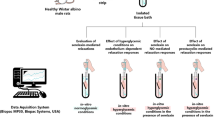Abstract
The neurotransmitters and vasoactive substances regulating tone in the smooth muscle of the penile arteries/arterioles and the trabeculae of the corpora cavernosa are critical mediators of the state of penile erection. Contemporary research reveals a coordinated, intricate interplay between the pathways of vasorelaxation and vasoconstriction representing a most efficient physiological mechanism to initiate and maintain penile erection. This paper will focus on the role of the adrenergic constrictor pathways in penile erection and, more specifically, on the pre-junctional adrenergic mechanisms that regulate smooth muscle constriction. All neurogenic constrictor responses are related to the release of norepinephrine from adrenergic nerves that act on post-junctional alpha-1 and pre-junctional and post-junctional alpha-2 receptor subtypes. Based on the current state of knowledge, there are at least three pre-junctional mechanisms regulating penile smooth muscle tone. First, norepinephrine release from the adrenergic nerves binds to the pre-junctional alpha-2 adrenoceptor on the adrenergic nerves and negatively regulates norepinephrine release. Blockade of this reaction by selective alpha-2 receptor antagonists (e.g. yohimbine or delequamine) will enhance norepinephrine release. Second, norepinephrine release from the adrenergic nerves binds to the pre-junctional alpha-2 adrenoceptor on the non-adrenergic, non-cholinergic (NANC) nerves and inhibits nitric oxide synthesis and release. Blockade of this reaction by selective alpha-2 receptor antagonists (e.g. yohimbine or delequamine) will enhance nitric oxide release, facilitating erection. Finally, cholinergic nerves pre-junctionally inhibit norepinephrine release from the adrenergic nerve and stimulate the NANC nerve to increase nitric oxide synthesis and release. These observations indicate that different neurotransmitters regulate the adrenergic neurotransmission pathway. Based on the above concepts for pre-junctional and post-junctional regulation of smooth muscle tone, the most efficacious strategy to reduce adrenergic activity and facilitate penile erection is to combine alpha-1 and alpha-2 adrenergic receptor antagonists. In this case, any enhancement of norepinephrine release is of little importance because the alpha-1 receptor antagonist will impede this vasoconstrictor response. This will also enhance the release of nitric oxide, which increases smooth muscle relaxation and decreases contraction resulting in penile erection.
This is a preview of subscription content, access via your institution
Access options
Subscribe to this journal
Receive 8 print issues and online access
$259.00 per year
only $32.38 per issue
Buy this article
- Purchase on Springer Link
- Instant access to full article PDF
Prices may be subject to local taxes which are calculated during checkout
Similar content being viewed by others
Author information
Authors and Affiliations
Corresponding author
Rights and permissions
About this article
Cite this article
Saenz de Tejada, I., Kim, N., Goldstein, I. et al. Regulation of pre-synaptic alpha adrenergic activity in the corpus cavernosum. Int J Impot Res 12 (Suppl 1), S20–S25 (2000). https://doi.org/10.1038/sj.ijir.3900500
Published:
Issue Date:
DOI: https://doi.org/10.1038/sj.ijir.3900500
Keywords
This article is cited by
-
Toxicology of natural and synthetic aphrodisiacs
Rechtsmedizin (2020)
-
Effects of low-intensity shock wave therapy (LiST) on the erectile tissue of naturally aged rats
International Journal of Impotence Research (2019)
-
Plant-Derived Supplements for Sexual Health and Problems: Part 1—Trends over the Past Decade
Current Sexual Health Reports (2019)
-
Yohimbine relaxes the human corpus cavernosum through a non-adrenergic mechanism involving the activation of K+ATP-dependent channels
International Journal of Impotence Research (2009)



